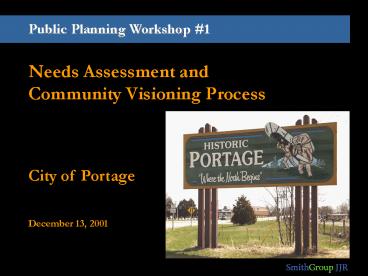Needs Assessment and Community Visioning Process - PowerPoint PPT Presentation
1 / 27
Title: Needs Assessment and Community Visioning Process
1
Public Planning Workshop 1
Needs Assessment and Community Visioning
Process City of Portage December 13, 2001
2
Purpose of Needs Assessment Community
Visioning
- Build a Database
- Maps, inventory, and analysis
- Assessment of Needs
- Community Visioning
- Where do you want to be in 10 - 20 years?
- A Foundation for Comprehensive Planning
- Planning Grant Application
3
Project Timeline
4
Smart Growth
Wisconsins Comprehensive Planning and Smart
Growth Law
5
Goals of Smart Growth
Protect Natural Areas and Farmland
Balance Property Rights with the Public Interest
6
Goals of Smart Growth
Promote Redevelopment and Infill
Provide a Variety of Transportation Choices
7
Goals of Smart Growth
Provide Adequate Infrastructure and Developable
Land
Promote Efficient Development Patterns
8
Goals of Smart Growth
Provide Sufficient Affordable Housing
Provide a Range of Job Opportunities
9
Goals of Smart Growth
Preserve Cultural and Historic Resources
Revitalize Main Street
10
Nine Required Elements
Comprehensive Plans prepared and adopted under
the new legislation must include the following
nine elements ? Issues and Opportunities ? Land
Use ? Housing ? Transportation ? Utilities and
Community Facilities ? Agricultural, Natural and
Cultural Resources ? Economic Development ? Interg
overnmental Cooperation ? Implementation
11
Issues and Opportunities
- 1.) Identify issues, assets and opportunities in
Portage - Consider the following categories
- Housing
- Transportation
- Utilities and community facilities
- Natural and cultural resources
- Economic development
- Intergovernmental cooperation
- Land use
- 2.) Prioritize the issues, assets and
opportunities
12
Residential Streets and Street Edges
Disliked No Trees, No Sidewalks, Garages Dominate
and are Closer to the Street than the Front Door
Liked Street Trees, Sidewalks, Short Setbacks,
Fenced Semi Public Space
13
Duplexes and Single Family Homes
Liked
14
Apartments and Townhouses
Disliked Building With Back to the Street,
Parking Dominating Entrance, Poor Landscaping
Liked Street Trees, Sidewalks, Short Setbacks,
Fenced Semi Public Space
15
Commercial Streets Street Edges
Disliked No Landscaping, Wide Roads, Large
Setbacks, Parking in Front of the Building
Liked Street Trees, Small Setbacks, Street
Furniture Narrow Roads, Wide Sidewalks
16
Commercial Buildings
Disliked Large Setback, Parking in Front,
Building Line is Destroyed
Liked Architectural Details, Pleasant Building
Line
17
The Rivers Edge
Disliked Poor use of Natural Amenity, Poor
Pedestrian Access, Parking on the Waterfront
Liked Well Defined Public Space, Good use of
Natural Amenity, Pedestrian Scaled Lighting
18
Parking
Disliked Large Lot in Front of the Building, Poor
Landscaping, Unsafe for Pedestrians and Transit
Riders
Liked Medium Scaled Parking, Good Landscaping,
Cars Screened From View
19
Civic Buildings and Schools
Disliked Single Story, Extensive Blank Walls Face
the Street
Liked Single Story, Multi-pane Windows, Short
Setback, Pedestrian Friendly, Architectural Design
20
Signs
Disliked Auto Scaled and Orientated, Poor Color
and Material Selection, Dominates the Building
Liked Ground Sign, Pedestrian Scale
21
Signs
Disliked Development Encroaching Upon Farm
Liked Intact Farm
22
A Vision for Duluth
2001 and Beyond
Duluth's unique physical beauty and diverse
cultural environment creates our competitive
advantage. Our people will work together, with
respect for each other, to ensure that
development is consistent with Duluth's future as
an urban wilderness, as a neighborly and safe
place to live, and as a place of high-skill,
high-wage employment.
23
(No Transcript)
24
(No Transcript)
25
PORTAGE Regional Context
26
PORTAGE Local Context
27
Why is Your Input Important?
- To insure that good plans remain intact over
time - Helps reduce contentious battles
- Speed up the development process
- To increase the quality of planning
- Enhance the sense of community
- Increase local trust in government
- Help make Portage a better place to live































